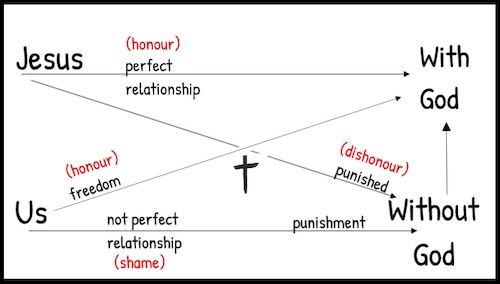Each of the videos on the Exploring Faith page were originally hand drawn diagrams I use to explain Christian ideas to enquirers. This section aims to teach people to draw these diagrams themselves. This will enable you to explain the gospel wherever you are, and in your own words.
Five lines that explain Christianity with simplicity
This video shows the background structure of the Key to Christianity. The main concept is that Jesus swapped places with us to bring us into relationship with God.
Rationale
The rationale behind this diagram has a number of aspects.
Logical not Chronological
Many gospel explanations begin with creation. This is a chronological place to start, but it’s not the logical place to start. If you start by speaking about creation you may get stuck there, you could end up down a rabbit-hole discussing the Big Bang Theory and the like. This is a discussion that needs to happen sometime, but not right at the beginning. If you want to talk about Jesus, then that’s a good place to start.
If you want to talk about Jesus, then that’s a good place to start.
Avoid Jargon
I’ve avoided using jargon in this diagram because while it may be clear to Christians, it’s definitely not clear to enquirers. As an example: ‘sin’ is described in relational language. There are three reasons for this.
- A relational understanding of sin is one of the very clear images used in the bible.
- People understand relationships and broken relationships. They are a familiar concept and experience.
- Using relational language avoids the misunderstanding that sin equals the bad things we do. This in turn avoids the common response of ‘but I’m a good person’.
The shape of the diagram is important in it’s simplicity. Avoid adding words if possible, it makes it more confusing.
I have very specifically chosen ‘not perfect relationship’ because to change to the grammatically correct ‘imperfect relationship’ implies a little bit wrong rather than wrong/broken/destroyed.
Honour and Shame Overlay
For a person from an honour/shame culture it’s possible to add language that connects more deeply. Using honour and shame is important, especially since dying on a cross is the most dishonourable death imaginable!
